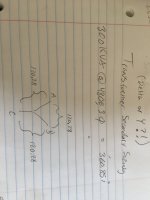Jpflex
Electrician big leagues
- Location
- Victorville
- Occupation
- Electrician commercial and residential
I’m trying to figure out secondary conductor sizing for assumed Y generator 300 KVA at 480 volts secondary at 3 phase
300,000 / 480v x 1.732 = 360.85 i total amperes
But is this total amperes to be divided equally between 3 phases AB, bc, ac? So that secondary are to be wired at 120.85 amperes x 1.25 for continuous loads? Does pick look right?
You would not wire each 3 legs at total 360.85 i amperes correct?
300,000 / 480v x 1.732 = 360.85 i total amperes
But is this total amperes to be divided equally between 3 phases AB, bc, ac? So that secondary are to be wired at 120.85 amperes x 1.25 for continuous loads? Does pick look right?
You would not wire each 3 legs at total 360.85 i amperes correct?

